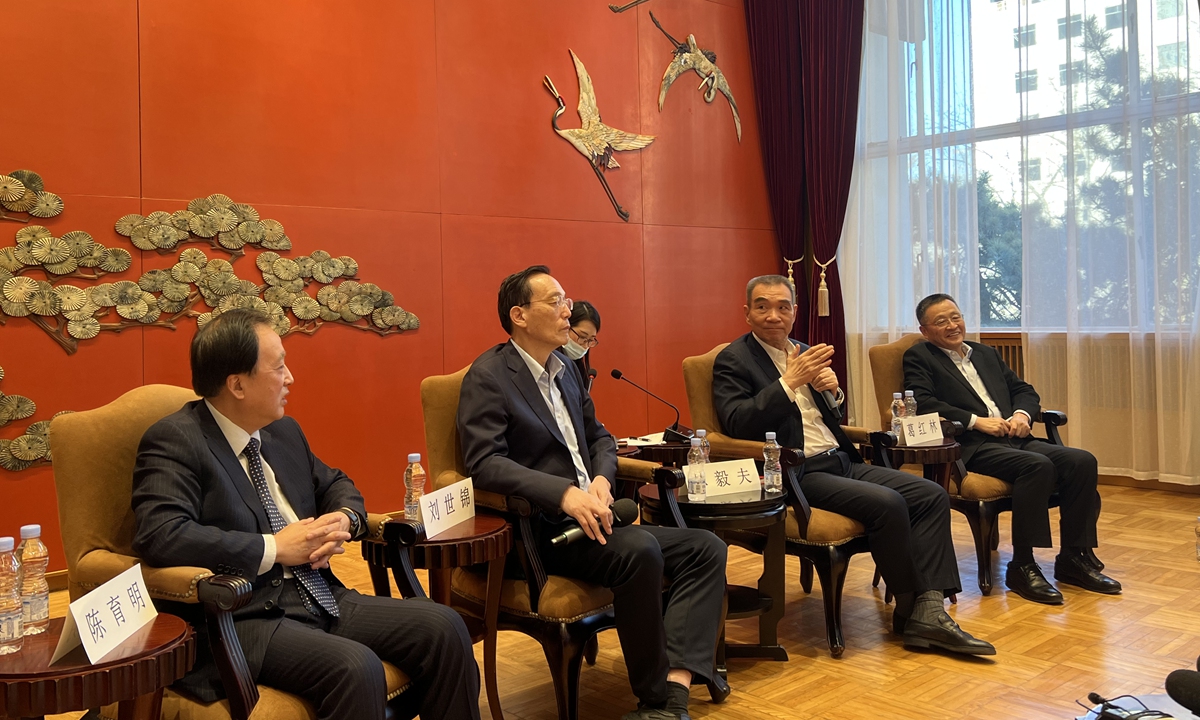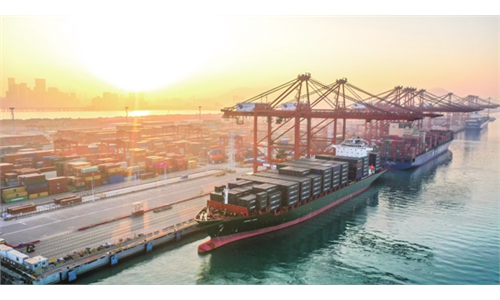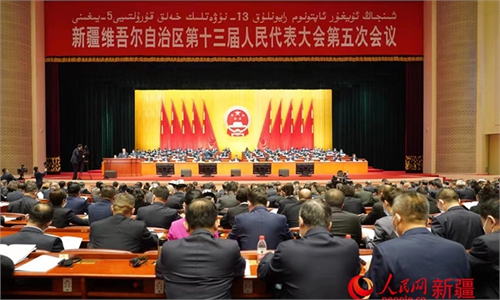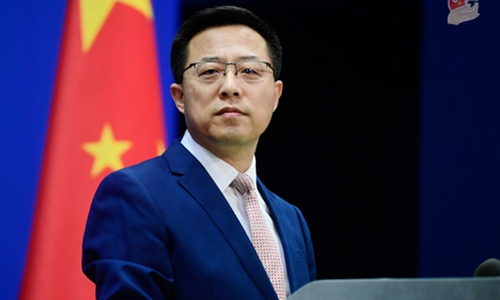China to become high-income country no later than the end of 2023: economists
Abundant policy toolbox, stability pledges make nation a locomotive for global growth

Economists share their views at an event held in Beijing by the China Public Diplomacy Association on January 21, 2022 themed "the current situation and future of the Chinese economy." Photo: Li Xuanmin/GT
Could the Chinese economy sail through the year 2022? The world's second-largest economy is well positioned to land at a growth rate above 5 percent this year, and the country is on trajectory to become a high-income country no later than the end of 2023, prominent Chinese economists said, sending an upbeat note for China to prelude a head start in 2022 while quashing a reverberating dim view of the prospects of the Chinese economy.
Skepticism has increased in recent days after Beijing released slower GDP growth of 4 percent in the last quarter of 2021, which prompted several international organizations including the IMF to cut China's 2022 GDP growth forecast. Some economists pointed to further softness in the property and consumption sectors, while some Western politicians vilified China's zero-tolerance COVID strategy, hinting at tremendous pain inflicted.
The above-mentioned remarks from renowned Chinese economists, coming after a slew of key interest rate cuts in recent weeks to shore up the economy, also offer a much-needed assurance to placate the market, against the backdrop of the US Federal Reserve's indication of a looming interest rate hike that sends a tightening turnaround in global monetary policy.
Analysts said that in stark contrast to elsewhere in the world, China's abundant policy toolbox and stability pledge will continue making it a haven for investment and a locomotive for global growth in the coming years.
Justin Lin Yifu, former chief economist of the World Bank and a member of the Standing Committee of the Chinese People's Political Consultative Conference (CPPCC) National Committee, said he is confident that China's economy will be able to grow around 6 percent in 2022, and the country will continue to be a driver of growth in the world in the coming decades.
Lin made the remarks at an event held by the China Public Diplomacy Association on Thursday themed "The Current Situation and Future of the Chinese Economy."
He predicted that China's 1.4-billion population will walk through the threshold of becoming a high-income country either this year or next year, which marks a landmark achievement in human history.
"There were only two economies that had successfully made strides from low-income to high-income since the World War II - the island of Taiwan and South Korea. The Chinese mainland could be the third," Lin said. He noted that this means by that time, about 34 percent of the world's population will be living in high-income countries, more than double the current level of around 16 percent.
In 2021, China's GDP per capita was around $12,551, according to the National Bureau of Statistics (NBS), nearing that of a "high-income country" as defined by the World Bank and overtaking the global average GDP per capita of $12,100.
"This is of symbolic significance because for a developing country, it is relatively easy to become a middle-income country. But staging on and transitioning into a high-income economy is quite difficult as most of them get mired in the 'middle-income trap' during the process," Liu Shijin, deputy director of the Economic Affairs Committee of the CPPCC National Committee, said at the forum, voicing confidence.
He predicted that China is "highly likely" to achieve a growth rate above 5 percent this year, and expansion could pick up from the second half. China usually announces its annual GDP target during the two sessions held in March, the major annual legislative meetings.
Downgrading forecasts
The forecasts of the two influential economists came after several international organizations and investment banks had downgraded China's GDP forecasts.
The IMF on Wednesday cut China's 2022 forecast by 0.8 percentage points to 4.8 percent, after a stellar 8.1-percent growth in 2021, the fastest expansion in a decade. On January 11, The World Bank also downgraded China's GDP growth estimate to 5.1 percent in 2022, from 5.4 percent in 2021.
Highlighting elevated risks of the Omicron variant spreading, those international organizations, as well as Western media, cited a string of downward factors on Chinese economy, including financial stress among property developers, slashed personal consumption, and "pandemic-induced disruptions related to China's zero-tolerance COVID-19 policy," as the IMF statement said.
Amid threefold pressure ranging from supply shock, weakened expectations and demand contractions - which China acknowledged in the tone-setting Central Economic Work Conference held in December, economists told the Global Times that some of the concerns are "justified" yet they fail to reflect the complete picture of China's structural growth potential and the Chinese government's readiness to stimulate the economy.
"Everyone is concerned about property, which has been weighing on China's second-half growth in 2021. But drives from property investment have peaked and this is a norm. So one of the priorities for government work in the first half [of 2022] is to otherwise stabilize infrastructure investment," Liu told the Global Times on Thursday, noting that authorities will be gearing up to a more proactive fiscal policy.
He also debunked Western media's hype over China's dynamic zero-infection policy.
"China's policy is a decision made in accordance with the country's actual realities. It is the most cost-effective one, which is proven by the 8.1-percent GDP growth rate last year factoring in the cost of anti-epidemic efforts. If we abandon the policy, the impact on production and employment is immeasurable, and the number of infections could be beyond China's hospitalization capacity," Liu said.
Lin estimated that from 2019 to 2035, China still has the potential of annual 8 percent growth. "We have the highest savings in the world, and the [ratio] of government's deficit as a percentage of GDP is among the lowest… We have resources for investment, and China will be able to maintain high investment growth," Lin said, indicating more government spending.
China's monetary and fiscal easing is already under way. At a meeting with the representatives of foreign experts on Wednesday afternoon, Chinese Premier Li Keqiang vowed to scale up the adjustment of cross-cycle macro policies, strengthen targeted coordination and take effective measures to cope with difficulties and stabilize market expectation, the Xinhua News Agency reported on Thursday.
Li's pledges come after the central bank last week lowered mortgage lending benchmark rates by 10-basis points for the first time in nearly two years. In making the rare move, the central bank also pledged to "open the monetary policy toolbox wider" to maintain the stability of total credit.
"China is not pulling any punches, and the country is one of the few economies in the world that is not rattled by high inflation and has more room for policy maneuvers to buttress its economy," Tian Yun, former vice director of the Beijing Economic Operation Association, told the Global Times on Thursday. "We could expect more pro-growth policies to unwind, and even a milder adjustment of the yuan's exchange rate."
On the other hand, the Western world led by the US is plagued by the pressure to rein in inflation and has emptied the toolbox to shore up growth. The US Federal Reserve said on Wednesday that an interest rate hike "will soon be appropriate," and analysts expect the hike could come in March.




